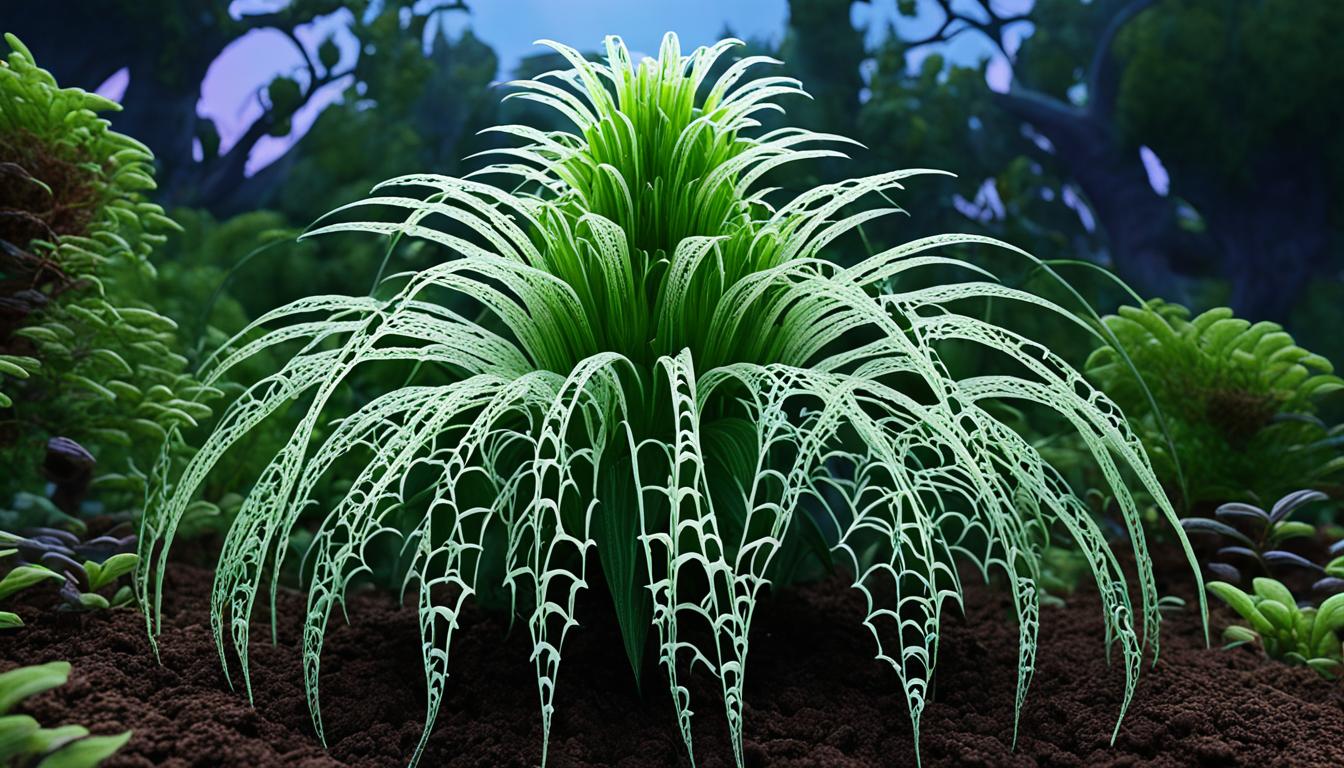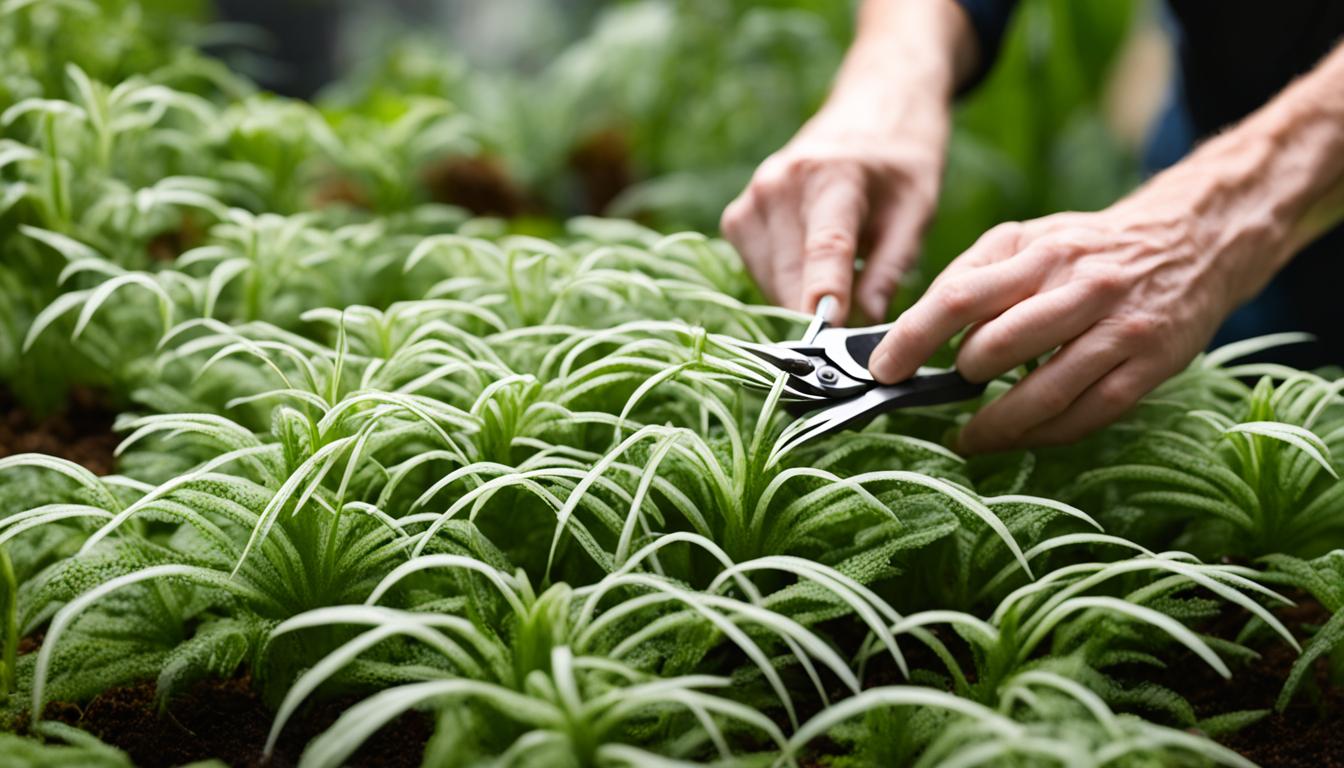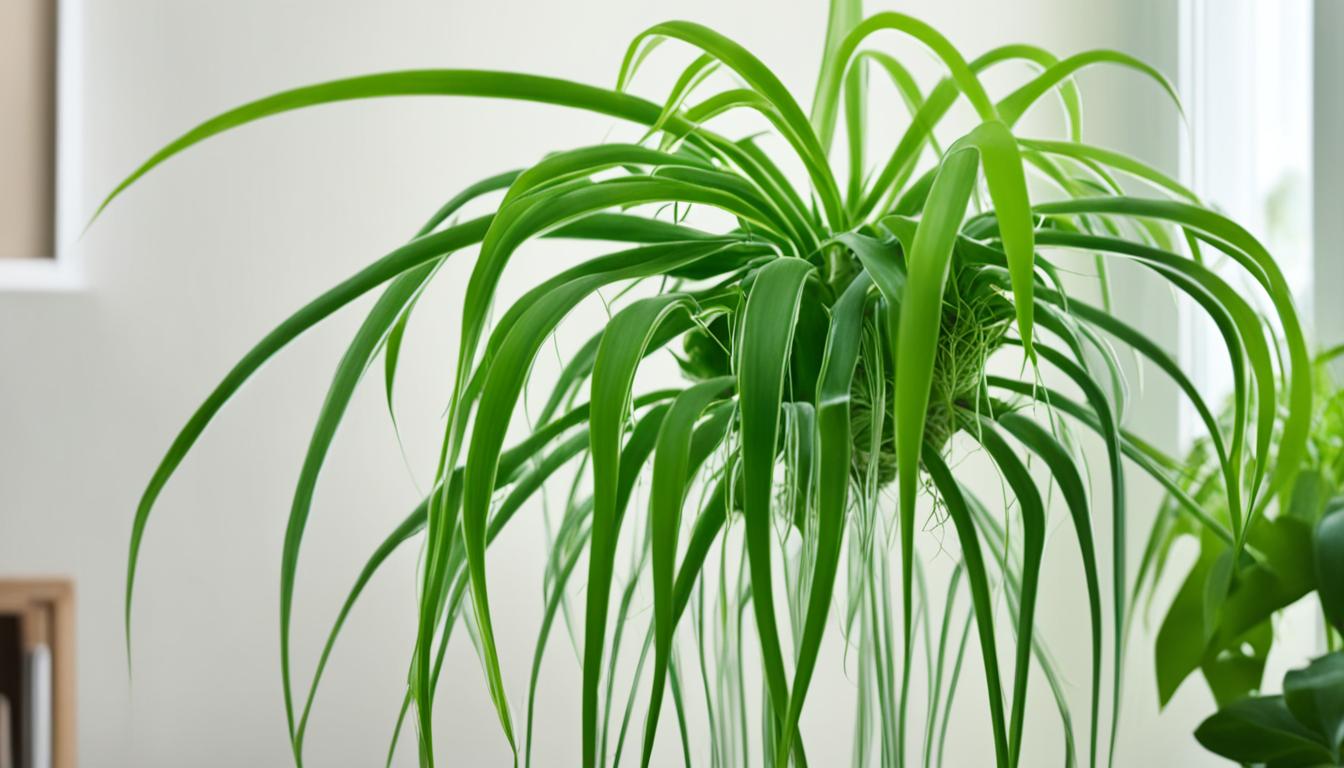Did you know a spider reverse plant can make over 100 new plants in just one year? This plant comes from places like Africa that are warm. It has really pretty leaves that people love. I find it so interesting how it grows so easily both indoors and outdoors.
The spider reverse plant looks amazing with its arching leaves and special colors. Anyone can enjoy having it, whether you’re good with plants or just starting. It’s great at cleaning the air, doesn’t need a lot of water, and is safe around pets. Let’s learn more about this plant, how to care for it, and why it’s great for any home or yard.
Key Takeaways
-
The spider reverse plant is a unique and eye-catching houseplant with stunning variegated foliage.
-
It is an easy-to-care-for plant that is adaptable to a variety of indoor and outdoor environments.
-
The spider reverse plant is known for its air-purifying abilities and is safe for pets and children.
-
Propagating the plant is a simple and rewarding process, allowing you to create new plants from offsets.
-
This versatile plant can be used in hanging baskets, as ground cover, and for a variety of decorative purposes.
Introducing the Captivating Spider Reverse Plant
The spider reverse plant is also known by its scientific name, Chlorophytum comosum. It belongs to the Asparagaceae family. This herbaceous perennial is originally from Africa’s tropical and subtropical areas. It has become a favorite all over the globe.
Botanical Classification and Nomenclature
It is part of the Chlorophytum genus, which includes many types of plants. Known for its many houseplants, indoor plants, and outdoor plants. The name “comosum” shows its trailing growth. Its leaves are marked with beautiful patterns.
Native Habitat and Distribution
The spider reverse plant comes from Africa’s very green areas. It loves the warm tropical and subtropical places. This plant does well in different conditions. So, it’s great for hanging, trailing, or covering the ground.
Striking Foliage: The Allure of Variegation
The spider reverse plant stands out because of its unique leaves. The ‘Variegatum’ type has green leaves with white edges. On the other hand, the ‘Vittatum’ type has a white stripe down the green leaves’ center.
Chlorophytum comosum ‘Variegatum’
The ‘Variegatum’ kind is a real eye-catcher. It has long and narrow arching leaves that mix green and white. The fleshy, glossy, and smooth texture makes this plant a joy to look at.
Chlorophytum comosum ‘Vittatum’
The ‘Vittatum’ type offers a different take on variegated looks. Instead of white edges, it has a white stripe down each green leaf. The matte, textured leaves create an interesting visual effect.
Compact Cultivars: Ocean and Bonnie
There are compact varieties like ‘Ocean’ and ‘Bonnie’ for smaller spaces. These plants have green leaves and white, star-shaped flowers. This adds extra beauty to the plants.
Spider Reverse Plant Care and Cultivation
Caring for the spider reverse plant is easy. This makes it a top pick for plant lovers of all levels. They need bright, indirect light to do well. They can also do okay in some shade. But, too little light makes them lose their bright variegation.
Light Requirements
The spider reverse plant loves bright, indirect light. It can handle some low-light but may lose its vibrant colors. Place it where it gets several hours of bright, filtered sunlight each day to keep it looking great.
Soil Preferences
They like soil that drains well and keeps moisture but not too wet. Use a soil mix for houseplants. Or a mix of peat moss, vermiculite, and perlite. These provide the best conditions for the spider reverse plant.
Watering Needs
It likes to be watered regularly but not too much. Let the soil get a bit dry between waterings. Water when the top inch of soil is dry during the growing season. In the winter, water less to avoid over-soaking the soil.
Temperature and Humidity Considerations
Keep this plant in warm temperatures between 65°F and 85°F (18°C and 29°C). It can handle some cooler temperatures but not for too long. Make sure the area has 40–60% humidity. This helps it stay healthy.
Fertilization for Optimal Growth
To get the best growth and colors, use a balanced, water-soluble fertilizer. Feed it every 2-3 months during the growing season. Don’t put too much fertilizer. This can make the plant grow too much, hiding its beauty.
Propagation and Repotting
Having a spider-reverse plant is very rewarding because it’s easy to make more plants. They make new plants, called offsets or “spiderettes,” at the end of their long stems. You can just pull these new plantlets off and grow them into brand-new spider-reverse plants.
Propagating from Plantlets (Offsets)
If you want to make more spider plants, find one with healthy offsets. Carefully cut off these baby plants from the main one. Leave a bit of the stem with them. After a day or two, put them in dry soil. Keep the soil wet, and soon you’ll see them grow roots and leaves.
Division of Mature Plants
Older and bigger spider reverse plants can be divided to make more. Take the plant out gently. Use a clean knife to cut it into smaller plants with roots and leaves. Then, plant these pieces by themselves or in different pots.
Repotting Tips for Spider-Reverse Plants
Repotting your spider reverse plant is crucial every one to two years. This is when it gets too big for its pot. Choose a bigger pot and the right soil. Take the plant out carefully and put it in the new pot. Make sure not to cover the top of the plant with soil.
Unique Traits and Benefits
The spider reverse plant is not just pretty; it’s also great for our air. It can remove bad stuff like formaldehyde from the air. This makes it perfect for inside our homes or outside.
Air-Purifying Abilities
This plant is like a natural air cleaner. It takes in stuff that can make us sick and gives us fresh air. This keeps our kids and pets safe from harm.
Drought Tolerance and Adaptability
It’s also tough and doesn’t need a lot of water. The spider reverse plant can live in many different places. So, anyone can grow it and enjoy its beauty.
Pet-Friendly and Child-Safe
It’s a great choice for families because it’s safe around pets and kids. Unlike some plants, it won’t hurt them if they touch it. This makes life easier for families with a lot going on.
Decorative Versatility and Appeal
The spider reverse plant is not easy to care for. It’s also great for decorating. It looks amazing in hanging baskets and trailing displays. The long leaves flow down from the container. This creates a beautiful look.
Hanging Baskets and Trailing Displays
The spider reverse plant suits hanging baskets and trailing displays perfectly. Its lush, trailing leaves make a striking scene. This plant adds natural beauty inside or outside your home.
Ground Cover and Edging Options
It’s not just for hanging. This plant is great as ground cover or edging. It fills garden gaps or lines paths well. Its vivid leaves form a decorative blanket in gardens.
Indoor and Outdoor Versatility
This plant fits in indoor and outdoor spaces easily. It’s perfect for decoration. Whether inside or outside, it brings a unique beauty.
Conclusion
The spider reverse plant is truly captivating and versatile. Its variegated leaves are eye-catching. It’s easy to care for and cleans the air. Also, it fits well in any space. Whether in a basket or on the ground, it adds beauty. This makes it perfect for anyone, even if you’re new to gardening.
This plant is perfect for homes with pets or kids. It looks amazing and is safe. Plus, it helps keep the air clean. Adding this plant to your space will bring joy to all who see it.
The spider reverse plant is a fantastic choice for anyone. Its beautiful leaves and low maintenance are great reasons to love it. I think many will enjoy having this plant in their homes for its unique charm.
<div class="quiz-container">
<h1> ️ Spider Reverse Plant - An Intriguing Botanical Wonder ️</h1>
<form id="spider-reverse-plant-quiz">
<div class="question">
<h2>1. What is unique about the Spider Reverse Plant?</h2>
<label>
<input type="radio" name="q1" value="a"> It grows upside down ⬇️
</label>
<label>
<input type="radio" name="q1" value="b"> It has reverse variegation pattern
</label>
<label>
<input type="radio" name="q1" value="c"> Its leaves change color with the seasons
</label>
<label>
<input type="radio" name="q1" value="d"> It blooms only at night
</label>
</div>
<div class="question">
<h2>2. How should you care for a Spider Reverse Plant?</h2>
<label>
<input type="radio" name="q2" value="a"> Water it daily
</label>
<label>
<input type="radio" name="q2" value="b"> Place it in direct sunlight ☀️
</label>
<label>
<input type="radio" name="q2" value="c"> Keep it in bright, indirect light
</label>
<label>
<input type="radio" name="q2" value="d"> Fertilize it weekly
</label>
</div>
<div class="question">
<h2>3. What type of soil is best for the Spider Reverse Plant?</h2>
<label>
<input type="radio" name="q3" value="a"> Sandy soil ️
</label>
<label>
<input type="radio" name="q3" value="b"> Clay soil
</label>
<label>
<input type="radio" name="q3" value="c"> Well-draining, rich soil
</label>
<label>
<input type="radio" name="q3" value="d"> Rocky soil
</label>
</div>
<div class="question">
<h2>4. How can you propagate a Spider Reverse Plant?</h2>
<label>
<input type="radio" name="q4" value="a"> By seeds
</label>
<label>
<input type="radio" name="q4" value="b"> By stem cuttings ✂️
</label>
<label>
<input type="radio" name="q4" value="c"> By air layering
</label>
<label>
<input type="radio" name="q4" value="d"> By root division
</label>
</div>
<div class="question">
<h2>5. What is a common pest that affects the Spider Reverse Plant?</h2>
<label>
<input type="radio" name="q5" value="a"> Aphids
</label>
<label>
<input type="radio" name="q5" value="b"> Spider mites ️
</label>
<label>
<input type="radio" name="q5" value="c"> Mealybugs
</label>
<label>
<input type="radio" name="q5" value="d"> Whiteflies
</label>
</div>
<button type="button" onclick="checkAnswers()">Submit</button>
</form>
<div id="results"></div>
</div>
<style>
.quiz-container {
font-family: Arial, sans-serif;
max-width: 600px;
margin: auto;
padding: 20px;
border: 2px solid #4CAF50;
border-radius: 10px;
background-color: #f9f9f9;
}
h1 {
text-align: center;
color: #4CAF50;
}
.question {
margin-bottom: 20px;
}
label {
display: block;
margin: 5px 0;
}
button {
display: block;
width: 100%;
padding: 10px;
background-color: #4CAF50;
color: white;
border: none;
border-radius: 5px;
cursor: pointer;
}
button:hover {
background-color: #45a049;
}
#results {
margin-top: 20px;
text-align: center;
}
</style>
<script>
function checkAnswers() {
const answers = {
q1: 'b',
q2: 'c',
q3: 'c',
q4: 'b',
q5: 'b'
};
let score = 0;
const form = document.getElementById('spider-reverse-plant-quiz');
const results = document.getElementById('results');
const formData = new FormData(form);
formData.forEach((value, key) => {
if (value === answers[key]) {
score++;
}
});
results.innerHTML = `<h2>Your Score: ${score}/5</h2>`;
if (score === 5) {
results.innerHTML += `<p> Excellent! You are a Spider Reverse Plant expert! </p>`;
} else if (score >= 3) {
results.innerHTML += `<p> Good job! Keep up the great work in caring for your plants! </p>`;
} else {
results.innerHTML += `<p> Keep learning and your Spider Reverse Plant will thrive! </p>`;
}
}
</script>
️ Spider Reverse Plant – An Intriguing Botanical Wonder ️
Relevant Articles:
Source Links
spider-reverse-plant


